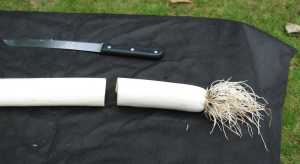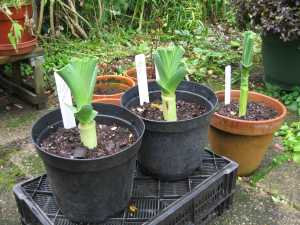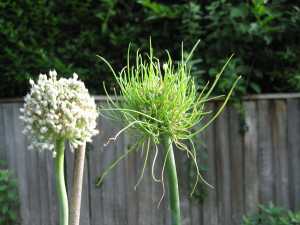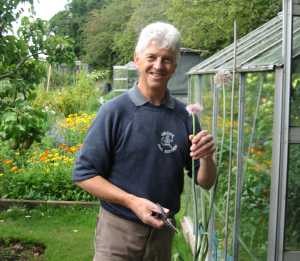
John Trim
Champion show grower John Trim explains the process of vegetative propagation of blanch leeks which is a fairly advanced technique but this step by step guide makes it easy to understand.
Visitors to the top shows are often amazed at the quality of the blanch leeks, but it comes as something of a surprise to most of them that the leeks are not grown from seed but by the process of vegetative propagation.
What is Vegetative Propagation?
Vegetative propagation is used by exhibitors to maintain a particular strain of leek. These strains have been hybridised and perfected by expert amateurs over many years. By vegetative propagation the strain is kept true to the original. It is rather like taking a cutting from a plant and growing it on.
The cutting will be a carbon copy of the parent. When growing for show this has obvious advantages to the exhibitor for as well as having all the good qualities of the parent plant it also becomes much easier to match the leeks for uniformity.

Cut off the bottom 6”/150mm, trim the roots and plant in a large pot.

Planted Leeks – Vegetative Propagation
Within days the leeks will be growing new foliage.

The leek head on the left is ready for trimming. The one on the right was trimmed 2 weeks before.

Now we wait for the leek grass to grow.
There are several ways of setting yourself up with a good strain of blanch leek. Buying young plants from a reliable source is a good way to start, but in that instance you will need to grow them on to maturity before you have a leek that you can use for vegetative propagation.
One of the best ways is to obtain a leek from an exhibitor at a show. A couple of leeks from a top grower will give you an excellent start. ‘Never be afraid to ask’
How to Propagate Leeks by Vegetative Propagation
Cut off 150mm of the leek barrel including the root plate. Trim the root down to 10mm then pop the prepared section into a bucket of disinfectant for 20 minutes. I use a tablespoon of Jeyes Fluid added to 4.5 litres of water. [Editor’s Note: This is not an approved use under EU regulations and we are not suggesting you do it, honest]
Select a 20 litre flower pot and fill with a good soil based compost such as John Innes No 3.
Dibber a hole and insert the leek to half it’s depth. Within a week the leek will begin to put up new leaf growth.
As long as the weather is not too severe the leek can remain outside in a sheltered position.
By May the following year the leek will throw a seed spike. These can grow quite tall so will need staking and tying in. The seed head will flower anytime from June into July.
Leek Grass
On the 1st of August cut all the flower stalks including the seed from the head, in effect giving it a crew cut. The leek is now bereft of all it’s seed and will respond by producing mini leeks on the head which is commonly called grass.
The seed head must be well supported at this time as we shall try to maintain the head of grass on the spike as long as possible. You will probably find by October that the stem has started to rot through.An indication of this is when the grass starts to wilt on the head.
Now is the time to cut off the head maintaining as much of the stem as possible. Stand the stem in a bottle of water which must be changed every three days. If you don’t you will find the stem will become a mush and the grass will wilt.
Every week check the bottom of the stem, if it is soft or mushy trim it back to healthy stem. The object is to maintain the head as long as possible before cutting and potting up the grass.
Pot them into individual plugs using a good seed compost. Levington F2 is my preference. The leeks can now be left to tick along in a cold greenhouse until 1st November when the heat goes on and the serious growing begins.




